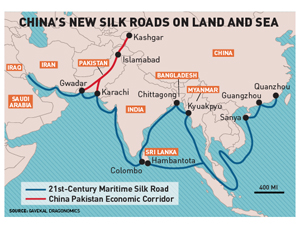The China Construction Industry Association, which represents the country's construction and engineering companies, is touting Xi Jinping's ambitious Silk Road and Maritime Silk Road international infrastructure programs, which the government calls the "One Belt, One Road" initiative.
The CCIA replied to ENR's questions through email.
ENR: Centuries ago traders established the Silk Road to move Chinese goods to the rest of the world. Please tells us about the new Silk Road.
CCIA: The One Belt, One Road program is a strategic and multi-layered initiative to establish an interconnecting network of infrastructure facilities across three continents, Asia, Africa and Europe, both by land and sea.
There are a lot of gaps in infrastructure linkages across this vast region. China will work with different countries to construct the international road, join the missing sections, get rid of road bottlenecks to ensure better access,promote construction and expansion of ports and create new waterways. It is a tremendously big business opportunity for everyone concerned.
China has a clear edge in road and port construction both in terms of machinery and project implementation capabilities. It is willing and ready to engage different countries in this effort.
Do you think project finance will get easier because of the $40-billion Silk Road Fund and $100-billion Asia Infrastructure Investment Bank?
CCIA: Making funds available is a crucial aspect of the program. The new institutions will not only provide loan support, they will also participate in the equity along with banks in different countries.
Getting several countries to participate and work together on one program is a difficult objective to achieve. How will you achieve cooperation?
CCIA: The program involves a lot of interconnectivity across regions and nations. Some projects pass through two or more countries at a time, and a lot of bilateral and multilateral issues will be involved. This is why communication and consultation among countries and stakeholders will be a key factor.
China is striving to build an atmosphere of open-minded co-operation between different countries.
Market forces will be allowed to play a decisive role in the allocation of resources, and determine the extent of participation by different companies. All concerned will adhere to best practices and international standards in project selection, planning and implementation.
We have to give priority to projects that have already been agreed upon. Conditions are ripe for building projects along an economic corridors in Pakistan and the BCIM corridor connecting Bangladesh, China, India and Myanmar.
China's domestic business has begun slow down, compared to preious years. How about the foreign business of Chinese construction companies? How have they fared since 2013?
CCIA: In 2013, foreign business of China's construction and engineering firms had a turnover of $137.14 billion, which meant an increase of 17.6%.
In 2014, foreign business of Chinese companies had a turnover of $142.11 billion U.S. dollars, an increase of 3.8%; new contracts amounted to $ 191.76 billion, an increase of 11.7%.
There were 55 Chinese enterprises on the ENR 250 Top International Contractors list in 2013 and 62 companies in 2014. The average turnover of the companies was around $1.25 billion.
Tell us about trends to watch in 2015:
This year has seen rapid growth in the number of new contracts signed in foreign locations by Chinese companies. Let me cite a few reasons why this is happening.
Infrastructure construction is being seen as a important means to stimulate economic growth in developing and less developed countries.
The process of regional economic integration has given rise to new demand for transnational projects.
The One Belt, One Road is being accepted for its strategic vision which combines construction capabilities with financing support. It will enhance China's overseas investments and take its construction business to a new level.


Post a comment to this article
Report Abusive Comment